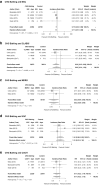Evidence for the effectiveness of chlorhexidine bathing and health care-associated infections among adult intensive care patients: a trial sequential meta-analysis
- PMID: 30567493
- PMCID: PMC6299917
- DOI: 10.1186/s12879-018-3521-y
Evidence for the effectiveness of chlorhexidine bathing and health care-associated infections among adult intensive care patients: a trial sequential meta-analysis
Abstract
Background: Health care associated infections (HAI) among adults admitted to the intensive care unit (ICU) have been shown to increase length of stay, the cost of care, and in some cases increased the risk of hospital death (Kaye et al., J Am Geriatr Soc 62:306-11, 2014; Roberts et al., Med Care 48:1026-35, 2010; Warren et al., Crit Care Med 34:2084-9, 2006; Zimlichman et al., JAMA Intern Med 173:2039-46, 2013). Daily bathing with chlorhexidine gluconate (CHG) has been shown to decrease the risk of infection in the ICU (Loveday et al., J Hosp Infect 86:S1-S70, 2014). However, due to varying quality of published studies, and varying estimates of effectiveness, CHG bathing is not universally practiced. As a result, current opinion of the merit of CHG bathing to reduce hospital acquired infections in the ICU, is divergent, suggesting a state of 'clinical equipoise'. This trial sequential meta-analysis aims to explore the current status of evidence for the effectiveness of chlorhexidine (CHG) bathing, in adult intensive care patients, to reduce hospital acquired infections, and address the question: do we need more trials?
Methods: A systematic literature search was undertaken to identify trials assessing the effectiveness of chlorhexidine bathing to reduce risk of infection, among adult intensive care patients. With particular focus on: (1) Blood stream infections (BSI); (2) Central Line Associated Blood Stream Infections (CLABSI); (3) Multi-Resistant Drug Organism (MRDO); (4) Ventilator Associated Pneumonia; and, Catheter Associated Urinary Tract Infections (CAUTI). Only randomised-control or cluster randomised cross-over trials, were include in our analysis. A Trial Sequential Analysis (TSA) was used to describe the current status of evidence for the effectiveness of chlorhexidine (CHG) bathing, in adult intensive care patients, to reduce hospital acquired infections.
Results: Five trials were included in our final analysis - two trials were individual patient randomised-controlled, and the remaining cluster-randomised-crossover trials. Daily bathing with CHG was estimated to reduce BSI in the ICU by approximately 29% (Der-Simonian and Laird, Random-Effects. (DL-RE) Incidence Rate Ratio (IRR) = 0.71, 95% confidence interval (CI) 0.51, 0.98); reduce CLABSI in the ICU by approximately 40% (DL-RE IRR = 0.60, 95% CI 0.34, 1.04); reduce MDRO in the ICU by approximately 18% (DL-RE IRR = 0.82, 95% CI 0.69, 0.98); no effect in reducing VAP in the ICU (DL-RE IRR = 1.33, 95% CI 0.81, 2.18); and, no effect in reducing CAUTI in the ICU (DL-RE IRR = 0.77, 95% CI 0.52, 1.15). Upper (superiority) monitoring boundaries from TSA were not crossed for all five specific infections in the ICU.
Conclusion: Routine bathing with CHG does not occur in the ICU setting, and TSA suggests that more trials are needed to address the current state of 'clinical equipoise'. Ideally these studies would be conducted among a diverse group of ICU patients, and to the highest standard to ensure generalisability of results.
Keywords: Chlorhexidine bathing; Intensive care; Meta-analysis; Preventing hospital acquired infection; Trial sequential analysis.
Conflict of interest statement
Authors’ information
Not applicable.
Ethics approval and consent to participate
Not applicable (review of published literature).
Consent for publication
Not applicable.
Competing interests
All authors have no competing interests to declared.
Publisher’s Note
Springer Nature remains neutral with regard to jurisdictional claims in published maps and institutional affiliations.
Figures




References
Publication types
MeSH terms
Substances
LinkOut - more resources
Full Text Sources
Medical
Research Materials

